11 Mar 2014 | Americas, News and features, United States

(Image: Free Barrett Brown)
On 7 March, a US federal judge granted the government’s motion to dismiss the majority of its criminal case against journalist Barrett Brown. The 11 dropped charges, out of 17 in total, include those related to Brown’s posting of a hyperlink that led to online files containing credit card information hacked from the private US intelligence firm Stratfor.
Brown, a 32-year old writer who has had links to sources in the hacker collective Anonymous, has been in pre-trial detention since his arrest in September 2012 – weeks before he was ever charged with a crime. Prior to the government’s most recent motion, he faced a potential sentence of over a century behind bars.
The dismissed charges have rankled journalists and free-speech advocates since Brown’s case began making headlines last year. The First Amendment issues were apparent: are journalists complicit in a crime when sharing illegally obtained information in the course of their professional duties?
“The charges against [him] for linking were flawed from the very beginning,” says Kevin M Gallagher, the administrator of Brown’s legal defense fund. “This is a massive victory for press freedom.”
At issue was a hyperlink that Brown copied from one internet relay chat (IRC) to another. Brown pioneered ProjectPM, a crowd-sourced wiki that analysed hacked emails from cybersecurity firm HBGary and its government-contracting subsidiary HBGary Federal. When Anonymous hackers breached the servers of Stratfor in December 2011 and stole reams of information, Brown sought to incorporate their bounty into ProjectPM. He posted a hyperlink to the Anonymous cache in an IRC used by ProjectPM researchers. Included within the linked archive was billing data for a number of Statfor customers. For that action, he was charged with 10 counts of “aggravated identity theft” and one count of “traffic[king] in stolen authentication features”.
On 4 March, a day before the government’s request, Brown’s defence team filed its own 48-page motion to dismiss the same set of charges. They contended that the indictment failed to properly allege how Brown trafficked in authentication features when all he ostensibly trafficked in was a publicly available hyperlink to a publicly available file. Since the hyperlink itself didn’t contain card verification values (CVVs), Brown’s lawyers asserted that it did not constitute a transfer, as mandated by the statute under which he was charged. Additionally, they argued that the hyperlink’s publication was protected free speech activity under the First Amendment, and that the application of the relevant criminal statutes was “unconstitutionally vague” and created a chilling effect on free speech.
Whether the prosecution was responding to the arguments of Brown’s defense team or making a public relations choice remains unclear. The hyperlink charges have provoked a wave of critical coverage from the likes of Reporters Without Borders, Rolling Stone, the Committee to Protect Journalists, the New York Times, and former Guardian columnist Glenn Greenwald.
Those charges were laid out in the second of three separate indictments against Brown. The first indictment alleges that Brown threatened to publicly release the personal information of an FBI agent in a YouTube video he posted in late 2012. The third claims that Brown obstructed justice by attempting to hide laptops during an FBI raid on his home in March of that year. Though he remains accused of access device fraud under the second indictment, his maximum prison sentence has been slashed from 105 years to 70 in light of the dismissed charges.
While the remaining allegations are superficially unrelated to Brown’s journalistic work, serious questions about the integrity of the prosecution persist. As indicated by the timeline of events, Brown was targeted long before he allegedly committed the crimes in question.
On 6 March 2012, the FBI conducted a series of raids across the US in search of material related to several criminal hacks conducted by Anonymous members. Brown’s apartment was targeted, but he had taken shelter at his mother’s house the night prior. FBI agents made their way to her home in search of Brown and his laptops, which she had placed in a kitchen cabinet. Brown claims that his alleged threats against a federal officer – as laid out in the first indictment, issued several months later in September – stem from personal frustration over continued FBI harassment of his mother following the raid. On 9 November 2013, Brown’s mother was sentenced to six months probation after pleading guilty to obstruction of justice for helping him hide the laptops – the same charges levelled at Brown in the third indictment.
As listed in the search warrant for the initial raid, three of the nine records to be seized related to military and intelligence contractors that ProjectPM was investigating – one of which was never the victim of a hack. Another concerned ProjectPM itself. The government has never formally asserted that Brown participated in any hacks, raising the question of whether a confidential informant was central to providing the evidence used against him for the search warrant.
“This FBI probe was all about his investigative journalism, and his sources, from the very beginning,” Gallagher says. “This cannot be in doubt.”
In related court filings, the government denies ever using information from an informant when applying for search or arrest warrants for Brown.
But on the day of the raids, the Justice Department announced that six people had been charged in connection to the crimes listed in Brown’s search warrant. One, Hector Xavier Monsegur (aka “Sabu”), had been arrested in June 2011 and subsequently pleaded guilty in exchange for cooperation with the government. According to the indictment, Sabu proved crucial to the FBI’s investigation of Anonymous.
In a speech delivered at Fordham University on 8 August 2013, FBI Director Robert Mueller gave the first official commentary on Sabu’s assistance to the bureau. “[Sabu’s] cooperation helped us to build cases that led to the arrest of six other hackers linked to groups such as Anonymous,” he stated. Presuming that the director’s remarks were accurate, was Brown the mislabeled “other hacker” caught with the help of Sabu?
Several people have implicated Sabu in attempts at entrapment during his time as an FBI informant. Under the direction of the FBI, the government has conceded that he had foreknowledge of the Stratfor hack and instructed his Anonymous colleagues to upload the pilfered data to an FBI server. Sabu then attempted to sell the information to WikiLeaks – whose editor-in-chief, Julian Assange, remains holed up in the Ecuadorian embassy in London after refusing extradition to Sweden for questioning in a sexual assault case. Assange claims he is doing so because he fears being transferred to American custody in relation to a sealed grand jury investigation of WikiLeaks that remains ongoing. Though Sabu’s offer was rebuffed, any evidence linking Assange to criminal hacks on US soil would have greatly strengthened the case for extradition. It was only then that the Stratfor data was made public on the internet.
During his sentencing hearing on 15 November 2013, convicted Stratfor hacker Jeremy Hammond stated that Sabu instigated and oversaw the majority of Anonymous hacks with which Hammond was affiliated, including Stratfor: “On 4 December, 2011, Sabu was approached by another hacker who had already broken into Stratfor’s credit card database. Sabu…then brought the hack to Antisec [an Anonymous subgroup] by inviting this hacker to our private chatroom, where he supplied download links to the full credit card database as well as the initial vulnerability access point to Stratfor’s systems.”
Hammond also asserted that, under the direction of Sabu, he was told to hack into thousands of domains belonging to foreign governments. The court redacted this portion of his statement, though copies of a nearly identical one written by Hammond months earlier surfaced online, naming the targets: “These intrusions took place in January/February of 2012 and affected over 2000 domains, including numerous foreign government websites in Brazil, Turkey, Syria, Puerto Rico, Colombia, Nigeria, Iran, Slovenia, Greece, Pakistan, and others. A few of the compromised websites that I recollect include the official website of the Governor of Puerto Rico, the Internal Affairs Division of the Military Police of Brazil, the Official Website of the Crown Prince of Kuwait, the Tax Department of Turkey, the Iranian Academic Center for Education and Cultural Research, the Polish Embassy in the UK, and the Ministry of Electricity of Iraq. Sabu also infiltrated a group of hackers that had access to hundreds of Syrian systems including government institutions, banks, and ISPs.”
Nadim Kobeissi, a developer of the secure communication software Cryptocat, has levelled similar entrapment charges against Sabu. “[He] repeatedly encouraged me to work with him,” Kobeissi wrote on Twitter following news of Sabu’s cooperation with the FBI. “Please be careful of anyone ever suggesting illegal activity.”
While Brown has never claimed that Sabu instructed him to break the law, the presence of “persons known and unknown to the Grand Jury,” and whatever information they may have provided, continue to loom over the case. Sabu’s sentencing has been delayed without explanation a handful of times, raising suspicions that his work as an informant continues in ongoing federal investigations or prosecutions. The affidavit containing the evidence for the March 2012 raid on Brown’s home remains under seal.
In comments to the media immediately following the raid, Brown seemed unfazed by the accusation that he was involved with criminal activity. “I haven’t been charged with anything at this point,” he said at the time. “I suspect that the FBI is working off of incorrect information.”
This article was posted on March 11, 2014 at indexoncensorship.org
27 Feb 2014 | Egypt, Europe and Central Asia, Middle East and North Africa, News and features, United Kingdom
Comedian Andy Parsons and Channel 4 chief correspondent and presenter Alex Thomson were among the people gathered at Trafalgar Square today, in support of Al Jazeera journalists facing trial in Egypt on terror charges. Sue Turton, an Al Jazeera reporter who is accused of the same charge, was also present . The crowd staged a silent protest by taping their mouths shut and releasing black balloons.
The protest was part of a global day of action, where people around the world were asked to, at midday, cover their mouths, take a photo of themselves and post it online under the hashtag #FreeAJStaff.
Twenty journalists have been charged with “fabricating news and assisting or belonging to a terror cell”. Eight are in custody, including Al Jazeera’s Peter Greste, Mohamed Fadel Fahmy and Baher Mohamed. They have been imprisoned since 29 December and were last in court on 21 January, where they declared: “We are strong and we shall walk free”. The trial has been adjourned until 5 March.
Images from the protest below.
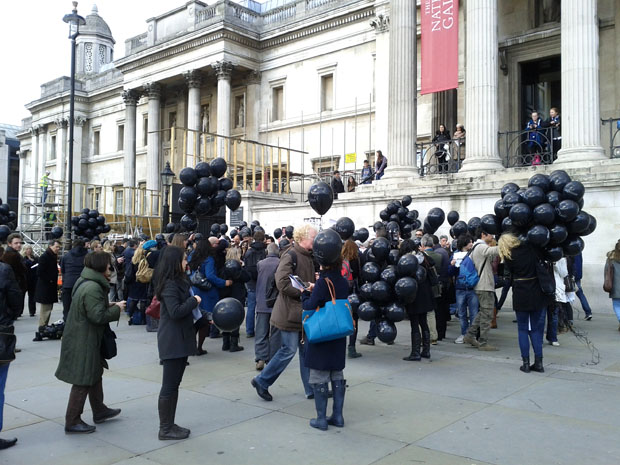
(Image: Index on Censorship)
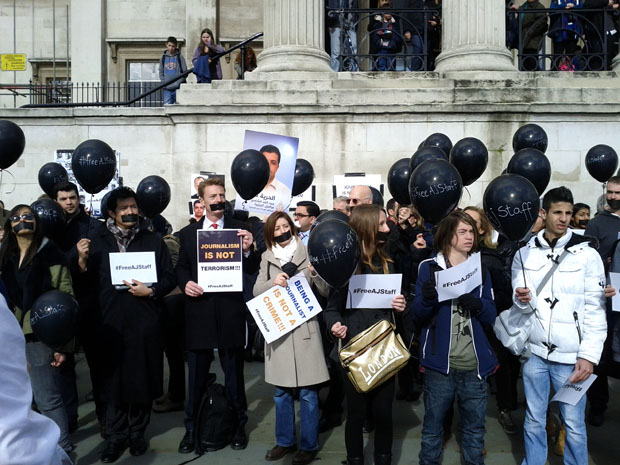
(Image: Index on Censorship)
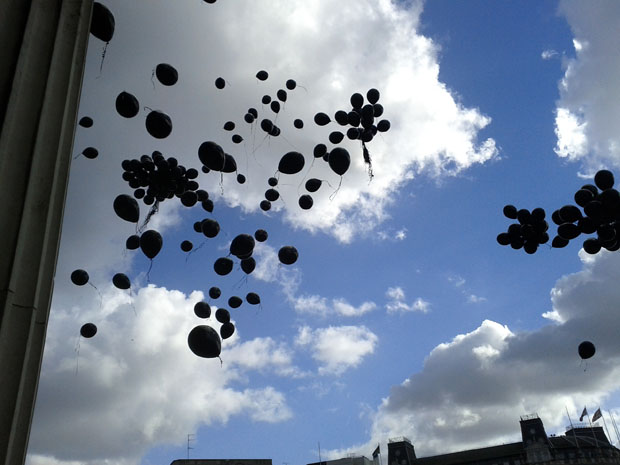
(Image: Index on Censorship)
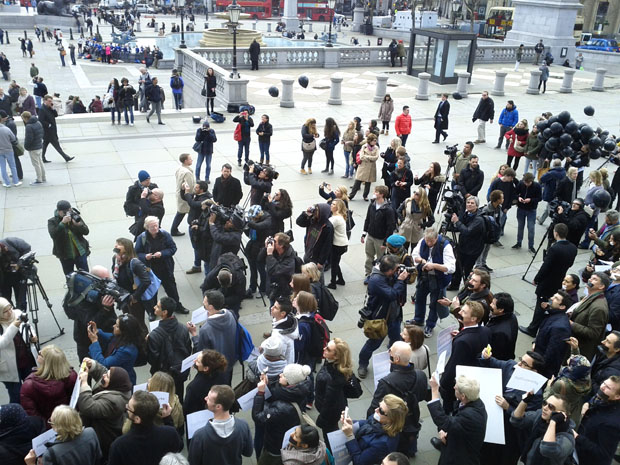
(Image: Index on Censorship)
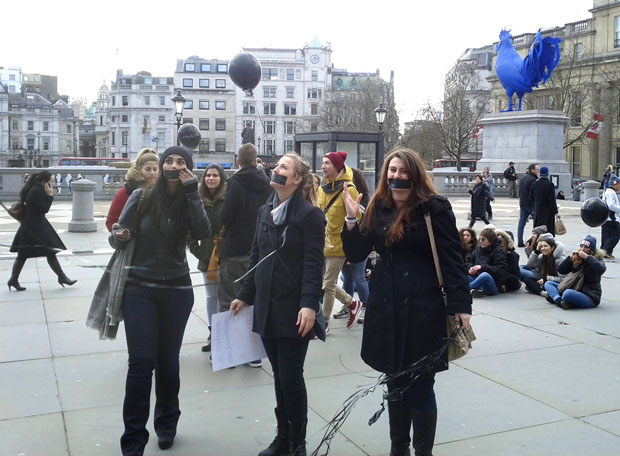
(Image: Index on Censorship)

(Image: Index on Censorship)

(Image: Index on Censorship)
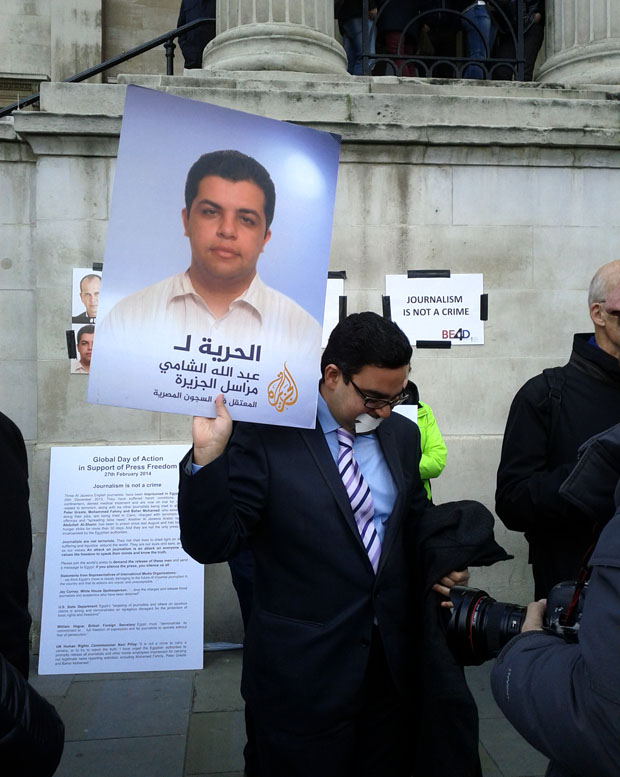
(Image: Index on Censorship)
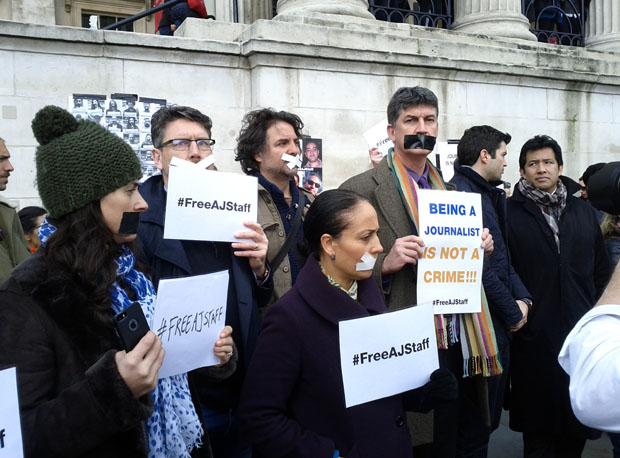
Alex Thomson (Image: Index on Censorship)
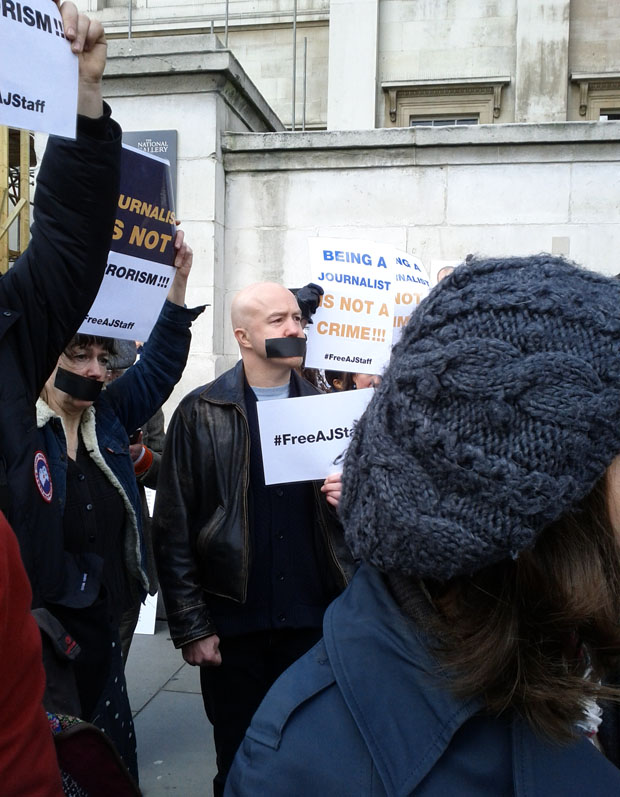
Andy Parsons (Image: Index on Censorship)
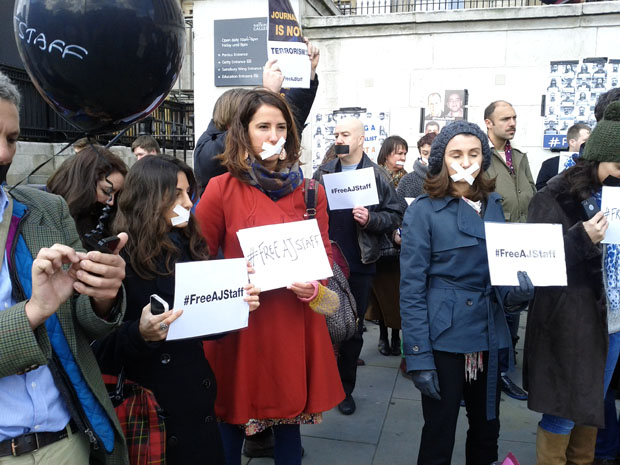
(Image: Index on Censorship)

(Image: Index on Censorship)
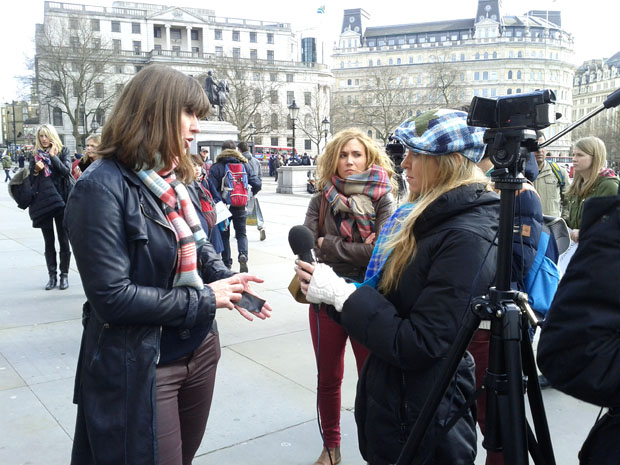
Sue Torton (Image: Index on Censorship)
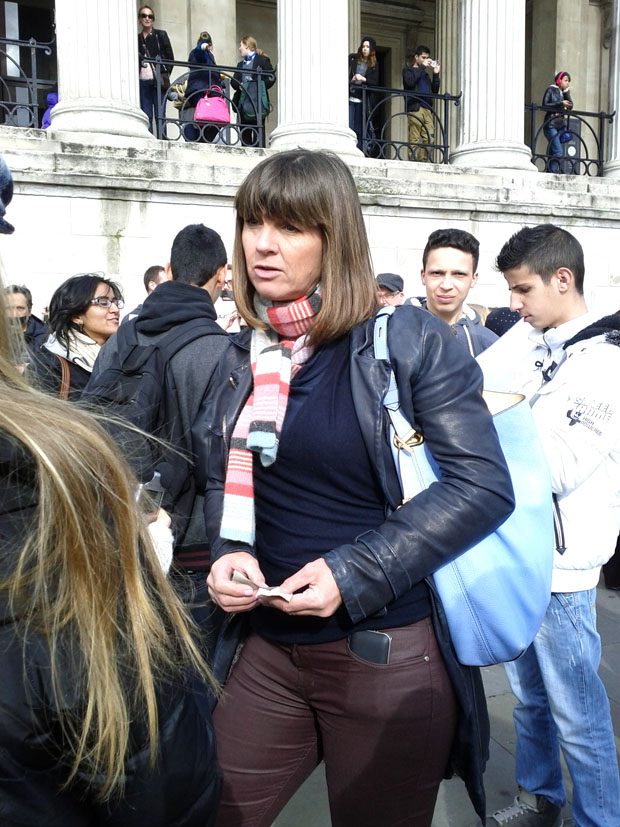
Sue Torton (Image: Index on Censorship)
This article was posted on 21 February 2014 at indexoncensorship.org
21 Feb 2014 | Americas, Brazil, News and features, Politics and Society

Rio’s Batman honours the recently deceased network cameraman Santiago Andrade, who died after being hit in the head with fireworks released by black bloc activists during a protest on February 6. (Photo: Leonardo Coelho / Demotix)
The death of Santiago Andrade on 10 February, a cameraman for Brazil’s Bandeirantes Network, from injuries he suffered while filming a Rio de Janeiro transport price protest has shocked the country.
In the uproar that followed, two protesters — Caio Silva de Souza and Fabio Barbosa Raposo – were arrested for targeting Andrade with fireworks. The media quickly filled with editorials and coverage that declared democracy was at risk. Journalists described the attack as a grave threat to freedom of expression and criticism of police handling of the protests. One op-ed even accused a leftist party deputy of links with the attack without presenting evidence.
However, there is a lack of preparation from the Brazilian press itself, when covering the demonstrations. This deficiency was highlighted by a BBC reporter who provided first aid to Andrade. Brazilian journalists usually cover protests without identification vests, protection or training.
Violence against the press is not a new problem in Brazil. There have been 126 attacks on journalists by police or demonstrators since the mass protest movement began in June 2013. It is common for journalists’ cars to be targeted by protesters. At the same time, it has been reported that journalists have been murdered for political reasons.
Brazil is the 11th most dangerous country for the journalistic profession, according to the Committee to Protect Journalists (CPJ). “The number of journalists killed has grown in recent years and the official government response has been insufficient. Brazil has become a dangerous country for the practice of journalism,” CPJ coordinator Carlos Lauría told UN Radio.
The attack on Andrade was the fourth episode of violence against journalists during protests in 2014. On 25 January, two reporters were injured in São Paulo — EFE reporter Sebastião Moreira and freelancer Paul Alexander were attacked by the police. UOL News reporter Gustavo Maia was assaulted by police on 6 February — the same day Andrade was injured.
The death of the cameraman happened at the same time the Brazilian Congress — with the backing of the federal government — was attempting to quickly pass two controversial bills against terrorism. The public reaction was overwhelmingly negative. The justice department is likely to present a new bill to congress. While the bill has not yet been published, it is said to provide stricter punishment for violent infiltrators in demonstrations, in addition to standardizing police responses throughout Brazil. The Minister of Justice, José Eduardo Cardozo, also met with representatives of the media and promised action to protect reporters.
Several national and international organizations expressed concern over the Andrade attack. The International Federation of Journalists (IFJ) and Reporters Without Borders called on the Brazilian authorities to guarantee the safety of journalists covering demonstrations. The UN expressed concern about violent protests and the “excessive use of force and arbitrary arrests of demonstrators and journalists by police forces”. UNESCO pleaded with Brazilian media groups to train their employees working in hazardous environments. The Brazilian Association of Investigative Journalism (Abraji) released a statement condemning the the attack and urged the Brazilian government to protect journalists and freedom of expression. The International Press Institute (IPI) recalled various crimes against Brazilian journalists and insisted that investigation of crimes against journalists be a priority for the government.
Brazil’s president Dilma Rousseff expressed her grief on Twitter. She said the death of Andrade “revolts and saddens” and stressed that “freedom of expression cannot be used to threaten life”. In an official statement, the Secretary of Human Rights of the Presidency said that “this case unfortunately tragically symbolizes the systematic violence against communication professionals engaged in covering demonstrations”.
From the standpoint of the investigations, this is a confusing story, full of questions, with different versions of events coming from the media and the police.
The lawyer for the men arrested for detonating the rocket said the two were recruited by, and received money from ,“activists”. The Civil Police claims there are infiltrators in protests that are paid by political parties of the extreme left.
The governor of Rio de Janeiro, Sergio Cabral, also said that “there are political parties and organisations embedded in these violent actions”.
Is there cooptation of popular movements? There is no evidence of it. Is Brazilian democracy facing a crisis? It seems that nobody wants to be responsible for the answers.
While the press is mourning the loss of yet another one of its own, there needs to be time to ascertain the facts rather than lob accusations when tensions are high. The press needs to investigate and confirm or deny the official line directed against the left or nothing will come from the death of a colleague symbolised by the cameras placed in front of the congress.
This article was posted on 21 February 2014 at indexoncensorship.org
14 Feb 2014 | Kenya, News and features, Politics and Society

Kenyan president Uhuru Kenyatta (Image Demotix/David Mbiyu)
In 2010 the International Criminal Court (ICC) issued summons for Uhuru Kenyatta and William Ruto, among others, for their alleged role in the violence that erupted following the 2007 Kenyan General Elections. The charges include crime against humanity. Nevertheless, in the elections of 2013, Kenyatta was sworn in as president — Ruto his deputy president — after securing 50.51 percent of the vote in a highly contested but generally peaceful election.
This now means that any movement to evaluate the defendants’ criminal culpability implicates the broader state itself. With Kenyatta and Ruto heading the executive branch of government, the implications of the ICC cases cannot be overstated. But while testing the state’s eagerness to confront the legacy of 2007 these cases offer up a further test; the ability of Kenya’s media institutions, journalists and citizens to freely interrogate the proceedings. Will Kenyatta, Ruto and, by extension, the state let such scrutiny happen in public?
Kenyan legislation in this regard is coloured by tragedy. Following the attacks on Westgate Mall in Nairobi in September 2013, the state moved fast to shore up perceived gaps in legislation that could have enabled the attacks to happen. One of these “gaps” referred to the media, ushering in two pieces of legislation: the Kenya Information and Communications (Amendment) Bill (KICA) and the Media Council Bill. The former, an amendment to the 1998 law, creates a Communication and Multimedia Appeals Tribunal under the jurisdiction of the state-controlled Communications Authority. According to free speech group Article 19, the tribunal has the power “to impose hefty fines on media houses and journalists, recommend de-registration of journalists and make any order on freedom of expression”.
While raising concerns for media bodies looking to cover the ICC cases of Kenyatta and Ruto among others, the Commission for the Implementation of the Constitution (CIC), have pointed out a number of more systemic issues. The 2010 constitution drafted to address the political and ethnic divisions that led to the violence of 2007 established robust protections for freedom of expression. KICA potentially undermines these protections, as CIC explained in a statement:
“Clause 7 of the Bill creates a Communications Authority of Kenya…with some of its board members appointed through a process that solely involves the National Executive and the National Assembly…These clauses violate the provisions of Article 34(3) of the Constitution by leaving the Body responsible for licensing broadcasters under the control of two arms of government, the Executive and the National Assembly.”
Any information deemed too sensitive to be in the public domain during the individual cases draws out KICA as a potential tool for the state to restrict the media’s ability to analyse the cases in an unobstructed manner.
The punitive measures outlined in KICA are not to be sniffed at. According to Charles Onyango Obbo of the Daily Nation: “The Sh20 million penalty against a media house that violated several provisions of the new Bill or the Code of Conduct for the Practice of Journalism, is again among the highest a tribunal can hand out in Africa.” A further provision states that media houses will face punitive measures if 45 percent of their coverage is not deemed “local”. The is a potential hindrance for media bodies looking to analyse the ICC cases – how local is The Hague?
Clause (37) of KICA goes on to state that the tribunal may “accept an anonymous complaint concerning an issue of public interest”. This inability for media bodies to identify its accusers opens the process up to manipulation. Can the tribunal determine that protecting Kenyatta and Ruto is in the public interest? When members of the tribunal are selected at the discretion of the National Executive, it is a possibility.
In the context of the ICC cases, this has created a perfect storm in terms of media freedom. Media houses face disproportionate measures, while their governance is outlined by a body at the discretion of both the executive and legislative branches of government – the former facing interrogation from both the ICC and the media.
It’s too early to tell what will happen and what powers will be invoked, but there have already been warning signs. A case was thrown out after it was alleged that a key witness had received a bribe from the defendant and questions remain regarding similar allegations in the case against William Ruto. Does this represent a collective desire to withhold information? The acts of alleged bribery are by no means definitive, but to skew proceedings, it would be the place to start.
And the next step? Media bodies must surely be holding their collective breath because, while they have not used them yet, KICA offers just the tools the state may need.
This article was posted on 14 February 2014 at indexoncensorship.org

















